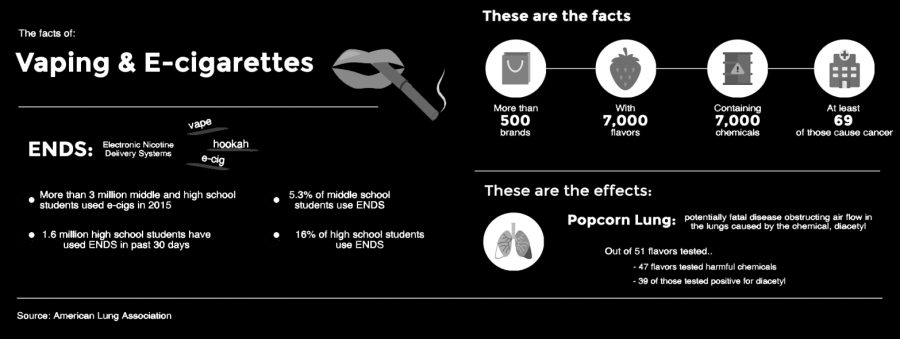Vape Culture
An explorative look in to the increasing usage of e-cigarettes at HHS
Jan 24, 2017
Tobacco companies spend $24 million a day–$1 million an hour–on marketing to their key demographic, teenagers.
While scrolling through Instagram, Twitter, or even leaving the HHS parking lot, people can be seen vaping.
From 2011 to 2015, e-cigarette use among high school students grew 900 percent with more than 3,000,000 high school and middle school students using an e-cigarette. With over 500 brands and 7,700 flavors, e-cigarettes are a growing phenomenon.
For the second consecutive year, e-cigarettes were the most commonly used tobacco product among youth.
The Royal Page has spoken with a student who wishes to remain anonymous because they are under 18, which is the legal age to smoke e-cigarettes.
“I do it because it is relaxing. When you get really good at it, you can do some awesome tricks,” the anonymous source said.
Although smoke tricks and the artsy pictures taken while using an e-cigarette can be intriguing, what chemicals may be inside of them may not be.
On Aug. 8, 2016, the U.S. Food and Drug Administration (FDA) ruled to extend their authority and began to regulate all products containing tobacco. This ruling meant the FDA can now legally regulate e-cigarettes, cigars, hookah, pipe tobacco,nicotine gels and dissolvables.
There are many myths that have been circulated to teenagers about e-cigarettes. When people started using e-cigarettes, they were advertised as a way to get the smoking experience without the exposure to nicotine. However, a 2014 study by the American Lung Association showed a wide-range of nicotine levels in most e-cigarettes.
Although nicotine is the most commonly known chemical in cigarettes, Diacetyl is a common flavoring chemical that has been known to cause popcorn lung, an irreversible disease that was found in the lung’s of popcorn factory workers. The popcorn lung-causing chemical has been found in 75 percent of e-cigarettes that were tested.
The need for e-cigarette regulation began to develop when studies showed numerous toxic chemicals within the e-cigarettes, such as formaldehyde and ingredients also found in antifreeze. Companies were not required to disclose ingredients or have their products contain warning labels or youth access restrictions because of their lack of regulation.
Although the FDA has begun to regulate Electronic Nicotine Delivery Systems (ENDS), there are so many different brands and flavors that the FDA won’t know what is in all them for a few years.
On Dec. 16, Gabby Gaspard, Respiratory Therapist and Tobacco/Nicotine Replacement Therapy Educator for Allina Health,spoke to health classes at HHS about the facts and dangers of using ENDS.
“Starting in 2018, you will know what you’re vaping. Right now, you don’t,” Gaspard said.
Along with the health effects, vaping can burn a large hole in a smoker’s wallet. The average flavor container is about 250 milliliters and $10 per container.
“It is really expensive, it’s about $20 a week,” the anonymous source said.
Second hand smoke is not just from regular cigarettes. Vaporizers and e-cigarettes can also let off second hand smoke, which can contain potentially cancer causing particles.
2014 was the biggest year for the fight against e-cigarettes.
Minn. passed a law on July 1, 2014 that prohibited the use of e-cigarettes and vaporizers in schools, health care settings, government buildings, daycare centers and foster care environments. Numerous cities and counties have also banned e-cigarettes wherever regular cigarettes are banned.
CVS Pharmacy banned the sale of tobacco products within 7,600 of their stores nationwide on Oct. 1, 2014.
According to the Campaign for Tobacco-Free Kids, if nothing is done to stop the marketing, selling and consuming of tobacco products, one billion people will be killed by tobacco.
Although e-cigarettes and vaporizers have been proven to have negative side effects, no studies have shown that the chemicals have any relation to a decline in school performance.
“It hasn’t affected my school at all because it doesn’t make me feel any different than I normally do,” the anonymous source said.
Although access to e-cigarettes and vaporizers has increased and their use has become more regular, there is still not enough information to show what is inside of them and what will happen to users in the long run.
“Are [e-cigarettes] safer than regular cigarettes? Maybe, we don’t have enough information to know if they are. Are they safe? Absolutely not, “ Gaspard said.

